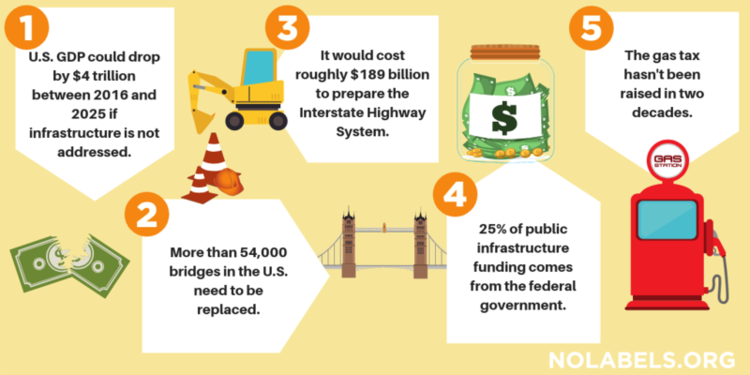
This past Memorial Day weekend an estimated 43 million Americans traveled to observe the holiday with friends and loved ones. Of these, close to 38 million traveled by car to reach their destination, traversing across the nation’s highways, over its bridges and through its tunnels. Unfortunately, a disproportionate number of these structures vital to our economic health are in dire straits. The American Society of Civil Engineers estimates that an investment of $4.5 trillion is needed to fix the country’s roads, bridges, tunnels, dams, and airports.
In Washington, there has been little headway in addressing these urgent infrastructure needs. Last week, President Trump walked out of a meeting with leading Democrats to discuss the topic and vowed not to address it again until the perceived personal attacks on him and the administration stop. This will halt any progress in addressing the crisis for the foreseeable future.
Here are five facts on the state of infrastructure in America:
1. A 2017 report from the American Society of Civil Engineers highlights that the United States’ GDP will drop by $4 trillion between 2016 and 2025 if infrastructure needs are not adequately addressed. This figure could balloon to $14 trillion by 2040 if action is not taken. The report also stresses that delayed action hurts American families too. Between 2016 and 2025 each household in this country is expected to lose $3,400 annually because of these deficiencies. And by 2025, 2.5 million jobs are expected to be lost if no additional investments are made.
2. Another report by the American Road and Transportation Builders Association released last year shows that more than 54,000 bridges in the United States have been deemed structurally deficient and need to be replaced. This means that almost nine percent of the country’s total bridges require critical repairs. These bridges are crossed more than 174 million times every day, according to CNN. And many, including New York City’s Brooklyn Bridge and Washington D.C.’s Memorial Bridge, also double as landmarks.
 3. In 2017, the U.S. Department of Transportation estimated it would cost roughly $189 billionto repair the Interstate Highway System and between $65 and $87 billion to restore highway conditions to 2010 levels. Yet in order to make sizable improvements to the Highway System, the country would need to spend close to $150 billion a year. This is part of the reason why the American Society of Civil Engineers gave U.S. infrastructure a D+ grade in its 2017 report.
3. In 2017, the U.S. Department of Transportation estimated it would cost roughly $189 billionto repair the Interstate Highway System and between $65 and $87 billion to restore highway conditions to 2010 levels. Yet in order to make sizable improvements to the Highway System, the country would need to spend close to $150 billion a year. This is part of the reason why the American Society of Civil Engineers gave U.S. infrastructure a D+ grade in its 2017 report.4. Right now just 25 percent of U.S. public infrastructure funding comes from the federal government; this is down from 38 percent in 1977, according to the Council on Foreign Relations. On top of this, the Highway Trust Fund, created in 1956 to create and maintain the Interstate Highway System, is facing insolvency. This fund raises money in part through the gas tax and other transportation-related taxes but could run out of money if changes are not made to its financial structure in the coming years.
5. Part of the reason the Highway Trust Fund is in financial straits is the the gas tax that hasn’t been raised in more than two decades. The last increase was in October 1993, according to NPR. This put the federal gas tax at 18.4 cents a gallon for unleaded fuel and 23.4 cents a gallon for diesel fuel. This means that states and local municipalities increasingly shoulder more of the burden for road repairs.

